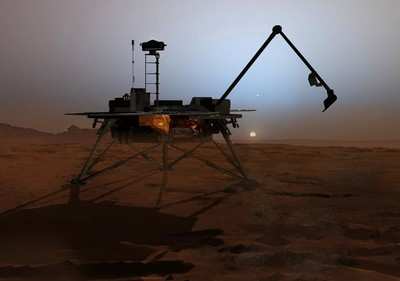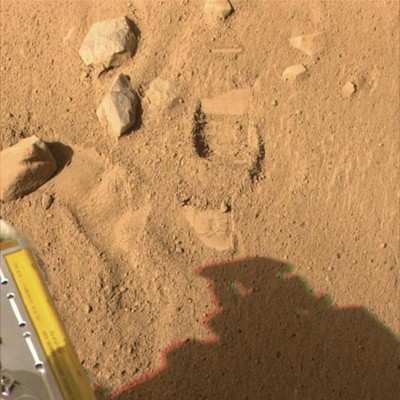Agency Expands Spacecraft's Mission
NASA announced Thursday that laboratory tests aboard its Phoenix
Mars Lander have identified water in a soil sample. The lander's
robotic arm delivered the sample Wednesday to an instrument that
identifies vapors produced by the heating of samples.

"We have water," said William Boynton of the University of
Arizona, lead scientist for the Thermal and Evolved-Gas Analyzer,
or TEGA. "We've seen evidence for this water ice before in
observations by the Mars Odyssey orbiter and in disappearing chunks
observed by Phoenix last month, but this is the first time Martian
water has been touched and tasted."
With enticing results so far and the spacecraft in good shape,
NASA also announced operational funding for the mission will extend
through Sept. 30. The original prime mission of three months ends
in late August. The mission extension adds five weeks to the 90
days of the prime mission.
"Phoenix is healthy and the projections for solar power look
good, so we want to take full advantage of having this resource in
one of the most interesting locations on Mars," said Michael Meyer,
chief scientist for the Mars Exploration Program at NASA
Headquarters in Washington.
The soil sample came from a trench approximately two inches
deep. When the robotic arm first reached that depth, it hit a hard
layer of frozen soil. Two attempts to deliver samples of
icy soil on days when fresh material was exposed were foiled
when the samples became stuck inside the scoop. Most of the
material in Wednesday's sample had been exposed to the air for two
days, letting some of the water in the sample vaporize away and
making the soil easier to handle.
"Mars is giving us some surprises," said Phoenix principal
investigator Peter Smith of the University of Arizona. "We're
excited because surprises are where discoveries come from. One
surprise is how the soil is behaving. The ice-rich layers stick to
the scoop when poised in the sun above the deck, different from
what we expected from all the Mars simulation testing we've done.
That has presented challenges for delivering samples, but we're
finding ways to work with it and we're gathering lots of
information to help us understand this soil."
Since landing on May 25, Phoenix has been studying soil with a
chemistry lab, TEGA, a microscope, a conductivity probe and
cameras. Besides confirming the 2002 finding from orbit of water
ice near the surface and deciphering the newly observed stickiness,
the science team is trying to determine whether the water ice ever
thaws enough to be available for biology and if carbon-containing
chemicals and other raw materials for life are present.
The mission is examining the sky as well as the ground. A
Canadian instrument is using a laser beam to study dust and clouds
overhead.
"It's a 30-watt light bulb giving us a laser show on Mars," said
Victoria Hipkin of the Canadian Space Agency.

A full-circle, color panorama of Phoenix's surroundings also has
been completed by the spacecraft.
"The details and patterns we see in the ground show an
ice-dominated terrain as far as the eye can see," said Mark Lemmon
of Texas A&M University, lead scientist for Phoenix's Surface
Stereo Imager camera. "They help us plan measurements we're making
within reach of the robotic arm and interpret those measurements on
a wider scale."
 OSH25 Day Four Redux: Spirit SE-1!, H55 eFlyer, King Schools
OSH25 Day Four Redux: Spirit SE-1!, H55 eFlyer, King Schools ANN Thanks Our Speedy Sponsor... Blackshape!!!
ANN Thanks Our Speedy Sponsor... Blackshape!!! Alpha Systems AOA Guides ANN Oshkosh Coverage
Alpha Systems AOA Guides ANN Oshkosh Coverage Pilot Mall Intro's High Flying Models To ANN Sponsor Lineup
Pilot Mall Intro's High Flying Models To ANN Sponsor Lineup CiES Fuels ANN's Oshkosh 2025 Special Event Coverage
CiES Fuels ANN's Oshkosh 2025 Special Event Coverage




